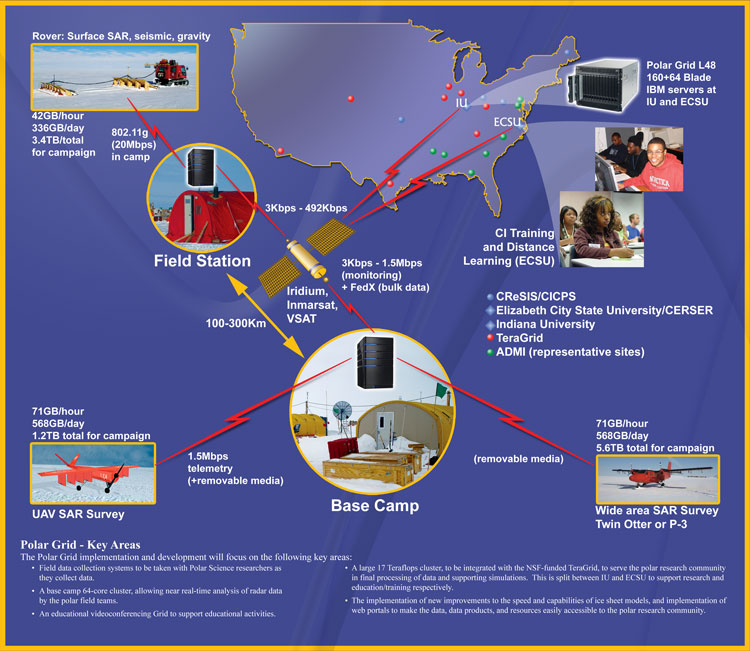| CERSER | Byrd Polar Research Center | CReSIS | ECSU | IU | KU | CERSER | NIA |

| Home | Team Members | Past Events | PolarGrid.org |
| Polar Grid |
The Polar Grid project collaborates with CERSER, CReSIS, and the Byrd Polar Research Center. For a list of team members and partners, see Team Members. Indiana University Article Minding the Data for Ice Sheets - Interview with Mr. Je'aime Powell, Polar Grid Manager Video Overview of the Polar Grid project September 24th, 2008 |
 ECSU Polar Grid Lab ECSU Polar Grid LabThe Polar Grid lab located In 111 Lane Hall at Elizabeth City State University (ECSU) serves dual roles as both a computer lab and telecommunications center. Primarily the lab functions as a computing center for CESER faculty and students. The lab contains 16 Apple iMac workstations, which have been configured to allow the use of three separate operating systems depending on faculty or student needs. The combination of Mac OS X, Ubuntu Linux, and Windows XP gives the user the freedom to explore various paths of research interest without worry of system compatibility. Desktop publishing, word processing, image manipulation, web design, geographic information systems (GIS), programming, and mathematical applications have been installed to allow versatility in the role the computers play in lab related activities. The addition of job scheduling applications such as Condor, Globus, and MatLab Distributed Computing Package, also allow the individual computers with dual cores to work together through the network as a single 32-node supercomputer. The computers combined with the installed digital projector, DVD/VCR, podium, and sound system allow the lab to easily transform into a digital classroom for guest speakers or presenters to interact with students and faculty. The secondary role the lab plays is that of a teleconferencing center. The installation of a Polycom 8000VSX has expanded the sphere of influence from the lab to beyond the walls of the room to connect with other universities and conferences. The Polycom system allows up to four outside participants to dial into the lab, which then becomes a virtual classroom. Each iMac workstation is also fitted with an internal camera through which telecommunications can take place. Through the Polycom system, it has become possible for students to view and interact with technical conferences and meetings that otherwise would have been monetarily unfeasible to attend. The addition of the Polycom system has also allowed faculty members the ability to better exchange ideas with partner institutions in related fields and projects. The addition of the V-brick Encoding system allows partner institutions to view lectures and student presentations in the Dixon Hall lab. This allows larger audiences to participate as the feed is transmitted through the Internet. The ultimate goal of Polar Grid is the creation of a large-scale distributed computing system to aide in the processing of data collected during polar expeditions. In October of 2008 the initial 64-node cluster will be delivered to ECSU in preparation for the final ~600-node cluster which is scheduled for January of 2010. This cluster will be housed in the ECSU E.V. Wilkins Academic Computing Center. At that time ECSU will be the first Historically Black College/University (HBCU) to house a cluster capable of acceptance into the national TeraGrid Project. The Polar Grid lab will be the center of all operations related to the use and support of that cluster and will grow as new projects, grants, and individuals utilize the cluster through cyberinfrastructure. |
National Science Foundation CI-TEAM Implementation Project Cyberinfrastructure for Remote Sensing of Ice Sheets NSF Grant OCI-0636361 Polar Grid NSF Grant CNS-0723054 :: CReSIS Award Number FY2005-108CMI Any opinions, findings, and conclusions or recommendations expressed in this material are those of the author(s) and do not necessarily reflect the views of the National Science Foundation. |
 Polar Grid is an
Polar Grid is an 